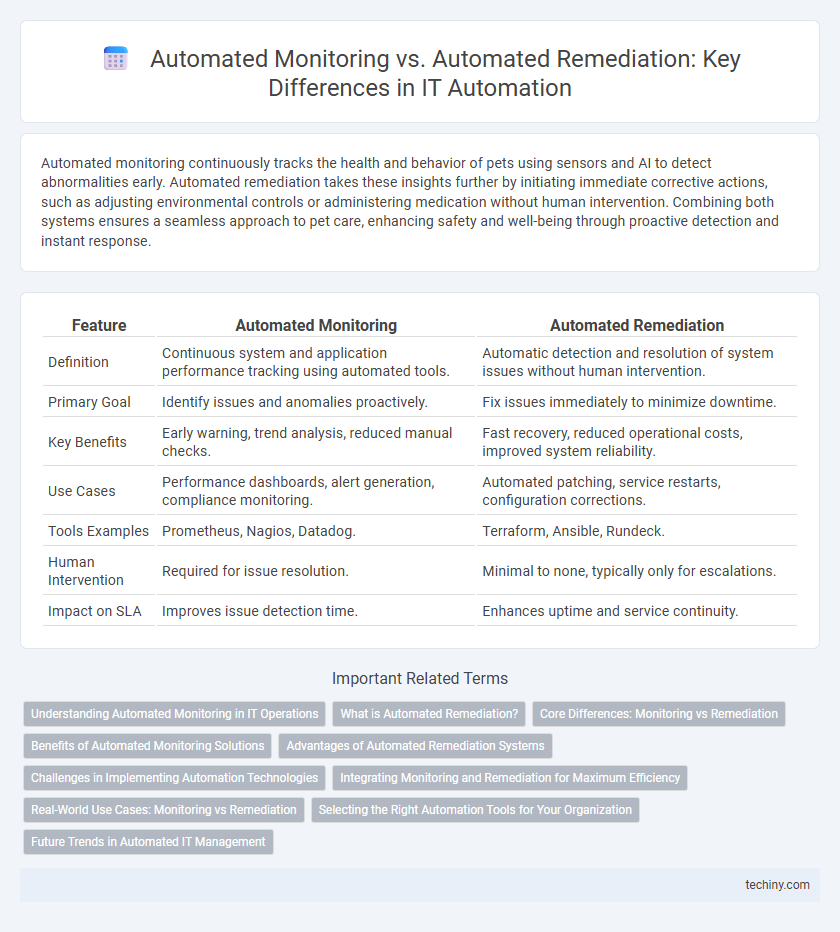Automated monitoring continuously tracks the health and behavior of pets using sensors and AI to detect abnormalities early. Automated remediation takes these insights further by initiating immediate corrective actions, such as adjusting environmental controls or administering medication without human intervention. Combining both systems ensures a seamless approach to pet care, enhancing safety and well-being through proactive detection and instant response.
Table of Comparison
| Feature | Automated Monitoring | Automated Remediation |
|---|---|---|
| Definition | Continuous system and application performance tracking using automated tools. | Automatic detection and resolution of system issues without human intervention. |
| Primary Goal | Identify issues and anomalies proactively. | Fix issues immediately to minimize downtime. |
| Key Benefits | Early warning, trend analysis, reduced manual checks. | Fast recovery, reduced operational costs, improved system reliability. |
| Use Cases | Performance dashboards, alert generation, compliance monitoring. | Automated patching, service restarts, configuration corrections. |
| Tools Examples | Prometheus, Nagios, Datadog. | Terraform, Ansible, Rundeck. |
| Human Intervention | Required for issue resolution. | Minimal to none, typically only for escalations. |
| Impact on SLA | Improves issue detection time. | Enhances uptime and service continuity. |
Understanding Automated Monitoring in IT Operations
Automated monitoring in IT operations involves continuous observation and analysis of system performance, network traffic, and application behavior using advanced tools like AI-driven analytics and machine learning algorithms. This process enables early detection of anomalies, capacity bottlenecks, and security threats without human intervention. Automated monitoring forms the foundation for proactive incident management by providing real-time insights essential for maintaining system reliability and uptime.
What is Automated Remediation?
Automated remediation is the process where software systems detect and fix IT infrastructure issues without human intervention, reducing downtime and operational costs. It combines real-time monitoring with predefined rules and AI-driven decision-making to automatically resolve incidents such as security breaches, system errors, or performance bottlenecks. This self-healing capability enhances system reliability and accelerates recovery, making it a critical component in modern IT automation strategies.
Core Differences: Monitoring vs Remediation
Automated monitoring continuously collects and analyzes system data to detect anomalies and performance issues in real-time, ensuring proactive visibility across infrastructure and applications. Automated remediation takes immediate action based on predefined rules or AI-driven insights to resolve detected problems without human intervention, reducing downtime and operational costs. The core difference lies in monitoring's role as a detection mechanism, whereas remediation serves as the execution phase to fix issues efficiently.
Benefits of Automated Monitoring Solutions
Automated monitoring solutions enable real-time detection of anomalies and performance issues across IT infrastructure, reducing downtime and enhancing system reliability. By continuously collecting and analyzing data, these tools provide actionable insights that facilitate proactive decision-making and resource optimization. This leads to improved operational efficiency, faster incident response, and reduced manual intervention compared to traditional manual monitoring methods.
Advantages of Automated Remediation Systems
Automated remediation systems significantly reduce downtime by instantly detecting and resolving IT issues without human intervention, enhancing operational efficiency. They improve accuracy in addressing complex system errors, minimizing the risk of human error and ensuring consistent compliance with security protocols. Real-time response capabilities optimize resource allocation and accelerate incident recovery, leading to improved system reliability and user satisfaction.
Challenges in Implementing Automation Technologies
Implementing automated monitoring faces challenges such as managing vast volumes of data and ensuring accurate, real-time anomaly detection to prevent false positives. Automated remediation struggles with the complexity of diverse IT environments, requiring precise decision-making algorithms to avoid unintended disruptions. Integration issues with legacy systems and maintaining security compliance further complicate the deployment of both automation technologies.
Integrating Monitoring and Remediation for Maximum Efficiency
Integrating automated monitoring with automated remediation enhances operational efficiency by enabling real-time detection and immediate resolution of system issues, minimizing downtime. Advanced monitoring tools equipped with AI-driven analytics identify anomalies, triggering automated remediation workflows that swiftly correct faults without human intervention. This seamless integration reduces manual workload, improves system reliability, and accelerates incident response times across IT environments.
Real-World Use Cases: Monitoring vs Remediation
Automated monitoring continuously tracks system performance and security metrics to detect anomalies in real-time, enabling rapid identification of potential issues such as unauthorized access or resource bottlenecks. Automated remediation immediately triggers predefined actions to resolve detected problems without human intervention, such as restarting failed services, patching vulnerabilities, or reallocating resources. Real-world use cases include cloud infrastructure where monitoring identifies unusual traffic spikes, and remediation automatically scales resources to maintain service availability.
Selecting the Right Automation Tools for Your Organization
Automated monitoring tools continuously track system performance and security metrics to detect anomalies in real time, while automated remediation solutions respond instantly to resolve issues without human intervention. Selecting the right automation tools requires evaluating compatibility with existing infrastructure, scalability, and the ability to customize workflows to meet organizational objectives. Integrating both automated monitoring and remediation enhances operational efficiency by minimizing downtime and accelerating incident response.
Future Trends in Automated IT Management
Automated monitoring leverages AI-driven analytics to continuously track system performance and detect anomalies, while automated remediation utilizes machine learning algorithms to instantly resolve issues without human intervention. Future trends in automated IT management emphasize the integration of predictive analytics and self-healing infrastructure, enabling systems to anticipate failures and execute corrective actions proactively. Emerging technologies like AI-powered orchestration and adaptive automation will enhance operational efficiency and reduce downtime across complex IT environments.
Automated Monitoring vs Automated Remediation Infographic

 techiny.com
techiny.com